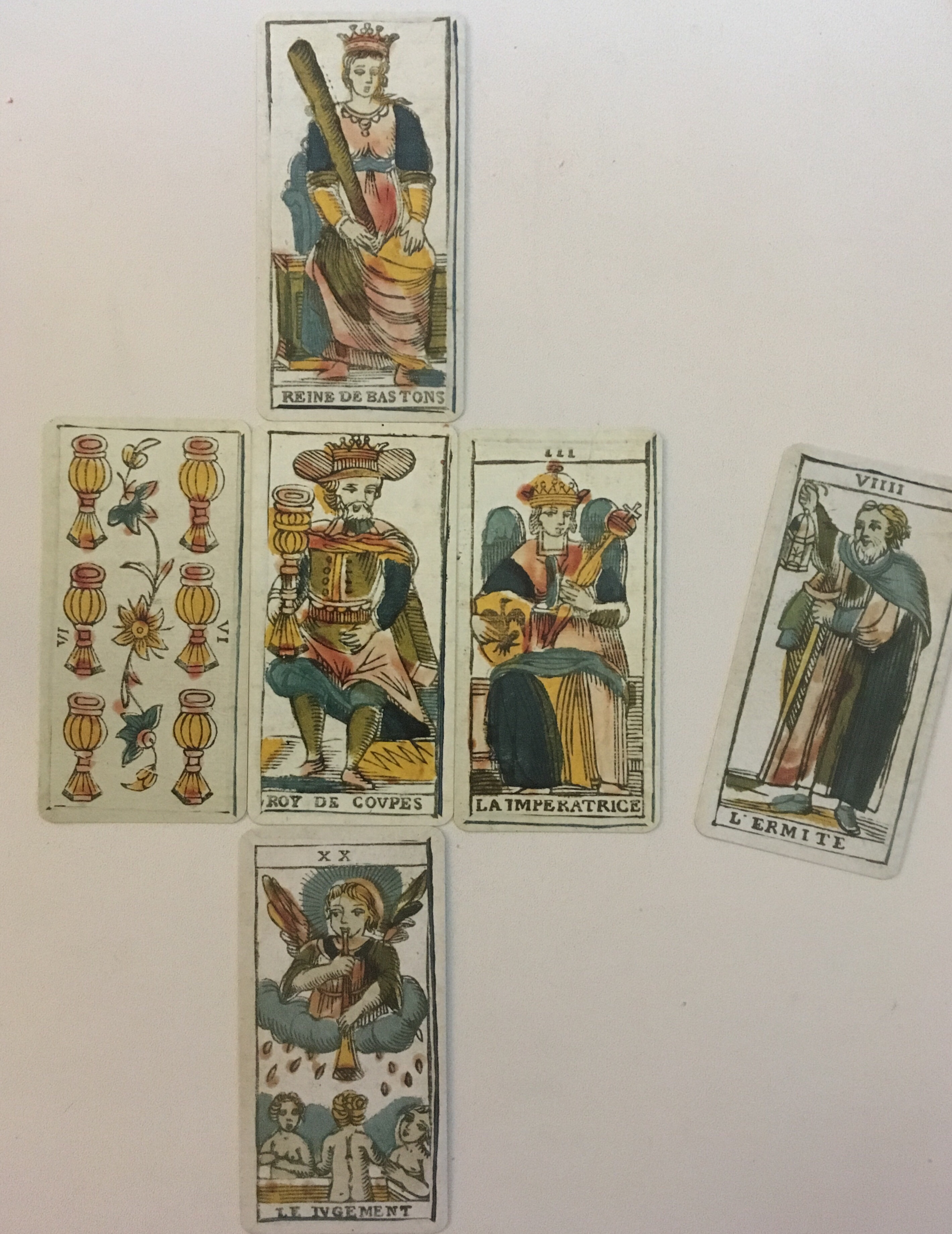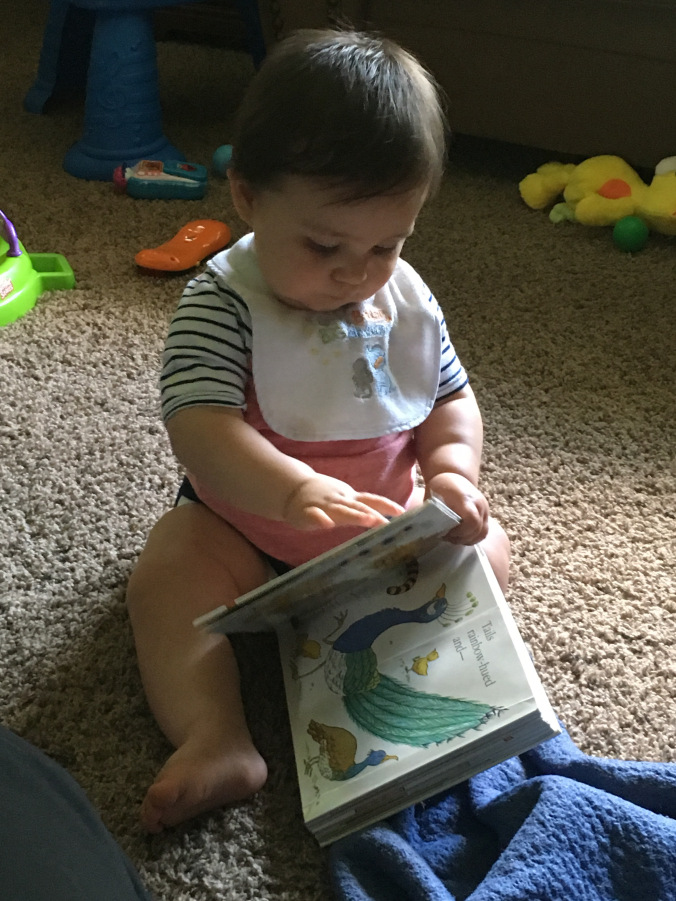For the Marseille reader, backgrounds are a bore. Everything’s white / whitish. In some cards, like the Moon or the Tower, have a nice background, with buildings, hills, lakes and whatever else graces the cards. Others, have some elements, usually hills, plants, water, things like that. But in all of them, when you look at the beyond the central figure, you face the white. In some, like La Force or L’ermit, white is all there is, and you either focus on the figure in front of you, or you’re faced with the emptiness around it.
Now I like the white space in the Marseille cards. In an age where every image is saturated with color and detail, it’s wonderful to rest your eyes in something that matters instead of having to fight your way through a ton of meaningless embellishments. After all, less is more and even though your sight is as keen as a lion’s, all that cutting down will soon dull your sight’s sharpness.
When dealing with the whole 78 cards of the Marseille deck, this white space is important, specially when reading the pips: do the objects have enough room to breath or are they crammed together? Can you devise a path between the coins / cups / spades or clubs or are they placed in a random order? All cues matter here and as with any other language, silence (or emptyness) is there to let you know when one thing ends and another starts.
If you’re just using the majors, chances are that all this emptiness won’t bother you. If you’re like me, you will take a cue from the remaining cards and assume that, unless otherwise noted, all the scenes before you are played outside. But like anything else in the cards, assumptions can be misleading and you should be careful, else you find yourself in the woods, with no light to guide you back.
It all starts with a question
Yesterday, I had a message in my facebook wall. A woman had met what she thought was a promising man and wanted to know how she should handle this. She was concerned because she had made some choices there weren’t that good and she didn’t want to tread that path again.
She was even more concerned, because as a seasoned tarot reader, she’s not used to not be able to read for herself, lucky her. After all, staring at yourself takes a lot, as you need to be detached from everything that connects you to the subject of your reading in order to fully understand what the cards are trying to say to you.
Time to bring out the swords
You can take this from a fully-pledged Thothite: ‘nothing beats the Marseille when what you want is instant clarity.’ There! I’ve said it. It’s really all in the whiteness: the lesser elements you have before you to consider, the better. Your eyes can cut to the chase and reveal the bones beneath in a snap.
My client gave me two concerns, so two spreads were in order: one about her future with this new acquaintance and a second one relating to her lack of vision. This meant that two spreads were in order.
What lies ahead for this woman and her new acquaintance?

The central line was clear enough: the meeting was pleasant and the two were in sync. There’s a good possibility that things might develop into something more, specially with this guy being represented by the gallant King of Cups. And yet… That Empress doesn’t seem too impressed! She’s looking away from the King of Cups and, even worse, her shield is facing our new guy. She’s leaning forward, trying to reach something, so an additional sight card was drawn: the Hermit.
My first reading of this additional card was a classic one: there’s something else at play here. Is she actually ready to let go of the loneliness or is she waiting for someone that has become absent? Questions, questions!!! And this card becomes even more important once you realize that the whole spread is directing your gaze to the Hermit. Surely this is the gist of the matter! But more on this latter.
Given the situation, what she should do was simple: she should open up to the new guy just enough to figure out how comfortable she was with him. If you look at Queen of Batons you will notice that the shield that the Empress has is gone. And more than that, the scepter the Empress held changed hands and is now leaning towards the King of Cups. You will also notice how the eyes are shut and the baton rests on her shoulder: there’s no need to remain alert anymore: things are good as they are. But she’s also facing that Hermit, so nothing’s really resolved. It’s more of a compromise than anything else: “be opened to what comes in, but don’t let go of your stuff.”
This idea is also corroborated with the Judgement card in the don’t position: “don’t blast your way in.” Again, things should be taken softly and without too many waves. Roll along quietly instead of making any sudden calls.
Why can’t she read the cards about this matter?

These are interesting cards. The three-card spread would suggest good things, but as La Force, below, indicated, it’s all about letting go. The 2 of Swords then, can be seen as this bubble she built around herself. There’s still enough room there for her to grow and develop, but what about what comes from the outside? Well, no matter how many flowers there are, it’s still not enough. Look at how the outside flowers are small when compared to what grows inside this bubble. The fear then, is that this situation might break this bubble. The central flower dulls and wanes as all those coins come into play. They might be good, but they sure feel like they’re too much to handle. And with that Judgement blasting in at full force, you can be sure that her bubble will pop!
The Hermit and Danger of Words
When she got back to me after the reading, her thoughts were on this bubble as related by the 2 of Swords. According to her, ‘I don’t really know what that “prison” is, however. I don’t consciously feel it so it’s hard to say.’
‘Well, it’s all in the cards’, I think… and I go back to that first spread and again my eyes stop at the Hermit.
Now, as tarot readers, we’re “educated” into seeing the usual concepts of loneliness and abandonment in the Hermit. “it’s the hermit, the one that leaves everything to pursue its goal of enlightenment”. All fair and good. But that really doesn’t play in here. There’s something else… Something important in the card, that only the Hermit can point to. And, as usual, something so clear and blunt it’s staring in your face, but you’re just too close to see it.
But all there is pictured there is this monk holding a lantern! There’s nothing else except that damned monk and its little light. And it hits me with the full might of a lion’s paw: ‘it’s the monk! That’s the thing about this card.’
The card is called “The Hermit”, but in the end, “Hermit” is just a word. And words have no business in cards, other than to facilitate the transmission of knowledge to the client. I should be hit 30 times for getting stuck in a word. ‘Loose the words, keep the pictures’, should be the motto of every card reader.
So, if you forget about the card’s name, everything becomes clear: like the hermit, a monk will withdraw from society to pursue its goals; but unlike hermits, monks live in monasteries. It’s normal for them to walk down shadowy corridors holding their light up to see the path ahead. And, unlike the free life of hermits, life in a monastery is all about routines: there are fixed times to pray, chores to do, etc etc.
Now routine is something that agrees with the story at hand: as we settle in our routines, we tend to see them as comfortable / safe / predictable. And when something comes to disrupt this routine, we might look at it wondering if all this commotion is actually worth the trouble of leaving the security of our little bubble for the uncertainty that waits outside. The more stable out life is, the less we’re inclined to change it to accommodate all the novelties that might come our way.
Thus, in this reading, the Hermit stands for the contentment that arises from routine. What this woman has is enough for her, or so she thinks. In this light, the QB in the “do” and the Judgement in the “don’t” make perfect sense. She should let down her shield (see how the shield in the Empress rhymes with the space delineated by the two swords in the following question) and allow him to come closer, but not change her routine over this. The fact that the new guy is represented got the KC as him is a good thing: he’s experienced (as opposed to Jack and Knight) and he knows what he wants. So you can allow yourself to relax a little and see what happens, while going about your stuff.
Her “prison” then it’s the routine she settled into: the way she’s comfortable with how things are. As the 2 of Swords indicates, this barrier she erected for herself works for her: the flower inside grows and blossoms. It defines her space and how content she is with it, as well as how ready she is to come outside. Loose the Words, Keep the Pictures In the end, it all really boils down to this little mantra. ‘Loose the Words, keep the pictures’. Words might feel safer, but it’s all an illusion. In reality, they have a way of sticking to you and soil things out. Pictures, on the other hand, will always point you out in the right direction. They are there for everyone to see. As tarot readers, we are asked to “see”, not “read”. Even that name, “tarot readers”, is misleading. Maybe we should be called “tarot seers” and just to keep looking at the pretty pictures wonder what might be hiding in there. When it comes to interpret pictures, everything can be useful; even a white background. Specially a white background. By forcing you to look at what really matters and loose all that doesn’t, that empty space is your best protection against all the noise that might creep in.Tarot deck: Der Lombardische Tarot
Advertisements Share this:




